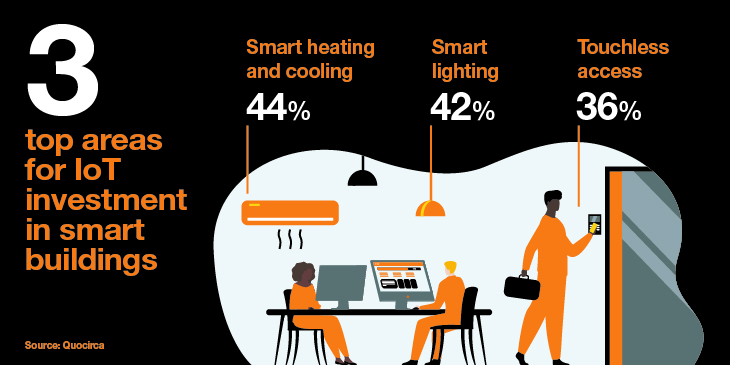The pandemic and its aftermath have presented employers with numerous questions and challenges. How can a commercial property be a safe place to work during a virus outbreak? And, with the remote working case proven, will employees still want to return to the office in the future? Research by PwC has found that 83% of employers said the move to remote work was successful for their company, and workers have certainly got used to working remotely.
But there is still value in a communal workplace where people can collaborate and exchange ideas face to face. It’s up to employers to provide workers with an environment that is safe, secure and attractive enough to want to come back to.
The smart buildings proposition
Smart buildings were already carving out a niche before COVID-19 arrived, providing enhanced office space and playing a role in the development of smart cities around the world. They could be set to really come into their own as the world continues to move on from the pandemic.
Early versions of smart buildings tended to focus on efficiency infrastructure and sustainability in facilities management. The following iteration added new features that leveraged digital technology and were more than merely building infrastructure, such as room scheduling, geolocation, space utilization and value-added Wi-Fi services.
The next generation of smart buildings leverages IoT sensor-based solutions and real-time data analysis to deliver tailored in-building experiences that meet the demands of workers and drive efficiencies and sustainability agendas. Further, and beneficially in today’s world, they can also help minimize health risks.
COVID-19 concerns and challenges
Companies need to address the fundamentals of operating in a post-COVID-19 world if they want to encourage workers back into the workplace with confidence. The traditional office layout is no longer viable, and being locked down for long stretches of the last year-and-a-half has moved the workplace focus much more onto the human experience. Building modernization projects need to concentrate on positively impacting the user experience and the health and safety of people who work in it.
We need to think more about how to limit occupancy of spaces to maintain physical distancing rather than maximizing available space. Hygiene, improved ventilation and reducing touchpoints around an office will become essential, along with a focus on mindfulness. Companies also should collect employee feedback about comfort and how safe they feel continuously. This will be a contributor to the smart building model, by providing more data points.
Internet of things (IoT) technologies are already at the forefront of monitoring smart buildings to drive safety and efficiency. Quocirca’s Smart Buildings and IoT Study found that 48% of European business decision-makers rank improving health and safety as their top reason for investing in smart building technology, while 76% of companies said they had increased their spending on IoT since last year. Cloud is another great enabling technology, allowing all a building’s systems to be interconnected to each other and to a central management system.
How can smart buildings make workplaces safer?
Post-COVID-19 thinking married to the latest digital technologies can make smart building workplaces more attractive to returning employees. Mobile apps can track workers around the office and trace anybody at risk who they might have had contact with. Smart buildings can also use sensors to measure workplace occupancy and occupancy analytics to ensure workers don’t exceed recommended maximum numbers in particular areas. They can also deploy thermal imaging solutions to help identify people with fever, for example. Sensor-based door and elevator controls, and touchless, voice-operated light switches will enable a zero-touch office environment.
Improving heating, ventilation and air conditioning (HVAC) systems can manage the building’s air filtration and purification to circulate air more safely. Research has demonstrated that keeping a building’s humidity between 40% and 60% can reduce transmission of cold and flu viruses by up to 70%. Better ventilation has other benefits: lower CO2 levels in buildings can make workers more productive. Research has found that high levels of CO2 cause a 23% impairment in decision making and an 11% reduction in workplace productivity.
Further to the intelligent control of HVAC systems, there is an environmental angle, too: buildings account for around 40% of global greenhouse gas emissions, something smart technologies can improve. Software, sensors and the use of innovative materials are making smart buildings more energy efficient in every area, from heating and lighting to security systems.

Deploying smart buildings
Incorporating all these new solutions into a building project can be expensive. However, building management companies can engage with managed service providers (MSPs) for smart solutions. MSPs can establish new, strategic partnerships to offer workplace solutions covering health and safety, sustainability services such as energy usage analysis to drive cost savings, overall comfort monitoring for building residents such as temperature, humidity, CO2 and similar, and even smart workplace productivity solutions like unified communications and collaboration (UC&C) tools and space monitoring.
Orange has developed Thing’in, an integrated research platform that supports a shared representation of physical and digital infrastructures. Thing’in can help make retrofitting a building with smart technologies simpler by pulling together, visualizing and actioning data from a building’s connected and unconnected objects.
Smart building deployment also needs to focus on security and privacy considerations. Cyberattacks have increased in general during the pandemic, and with more building systems being tied together, they present bigger attack surfaces. More data being shared by individual workers in a smart building will throw up privacy challenges, too, so there’s a balance to be struck between privacy and enhanced health and safety in work.
A smarter workplace for today and tomorrow COVID-19 has forced changes onto how we use buildings, but it presents an opportunity, too. IoT, cloud and other digital tools can make buildings safer, more attractive places for workers to return to and, in the longer term, contribute to sustainability initiatives and help develop smart cities.
If you would like to know more about how digital is transforming urban environments and creating smart buildings, read our whitepaper, and discover our Smart Cities capabilities in this brochure.

I’ve been writing about technology for around 15 years and today focus mainly on all things telecoms - next generation networks, mobile, cloud computing and plenty more. For Futurity Media I am based in the Asia-Pacific region and keep a close eye on all things tech happening in that exciting part of the world.